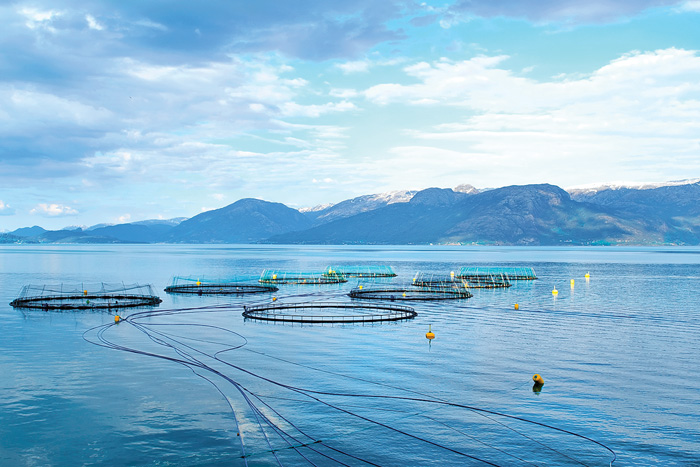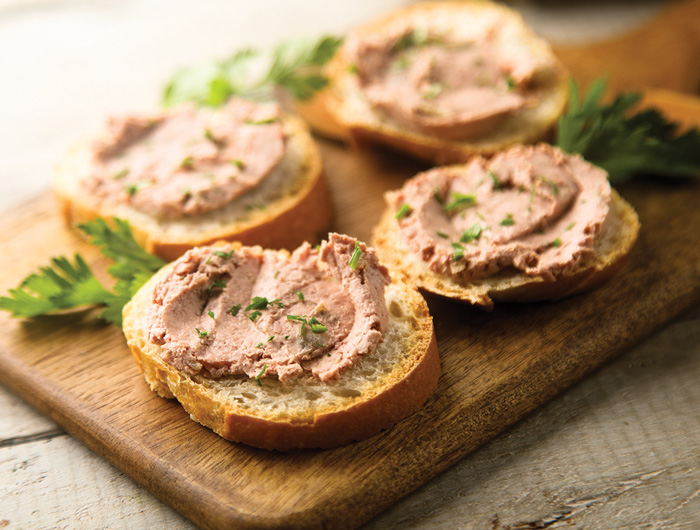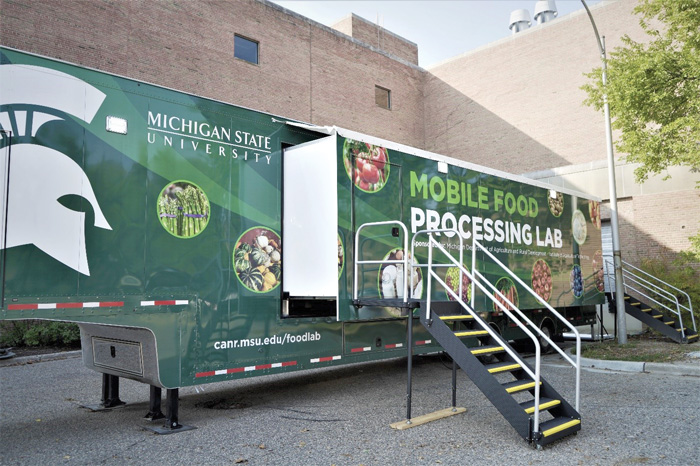NRA culinary forecast for 2022; The human mouth: molecular calorie detector
OMNIVORE
FOODSERVICE
NRA culinary forecast for 2022
RESULTS OF THE National Restaurant Association’s (NRA) What’s Hot 2022 Culinary Forecast indicate that health is taking center stage. Immunity-boosting foods and plant-based sandwiches appear in three of the report’s Top 10 Trends for 2022, with consumers seeking a balance between foods that provide comfort and those offering better-for-you options.
Among the immunity-boosting ingredients that are gaining popularity are tomatoes, seeds, berries, olive oil, and dark chocolate, all reputed to help stave off cancer, dementia, and viruses. Plant-based foods continue to make a showing as well, with plant-based proteins in sandwiches, breakfast sandwiches, and burgers all ranking among the top three in several categories. In addition, plant-based selections offer healthy, tasty, and sustainable menu alternatives in the face of animal protein supply shortages.
The What’s Hot 2022 Culinary Forecast is the result of a partnership between the NRA and the American Culinary Federation, whose professional chefs review and rank a list of 109 food items and culinary concepts identified by the association and Technomic’s Menu Research & Insights Division. Using their culinary expertise, chefs forecast what they think will reign on menus in the year ahead in 12 categories.
Top Regions Influencing Menus
- Southeast Asian (Vietnamese, Singaporean, Philippine)
- South American (Argentinian, Brazilian, Chilean)
- Caribbean (Puerto Rican, Cuban, Dominican)
- North African (Moroccan, Algerian, Libyan)
- Western African (Nigerian, Ghanan, Western Saharan)*
*For a look at West African foods that are making their mark, see New Products in this issue.
Top Breakfast Trends
- Nontraditional breakfast proteins (chorizo, vegan bacon)
- Plant-based breakfast sandwiches
- Egg-based breakfast bowls
Top Dessert Trends
- Alternative sweeteners (maple sugar, coconut sugar)
- Alcohol infusions
- CBD desserts
Top Condiment, Sauce, Spice, or Seasoning Trends
- Gochujang
- Tajin
- Harissa
Source: National Restaurant Association’s What’s Hot 2022 Culinary Forecast
RESEARCH
The human mouth: molecular calorie detector
A recent study led by the Monell Chemical Senses Center describes the first-in-human demonstration of a pathway in the human mouth that uses glucose to signal the presence of calories.
The research team was interested in data showing that taste bud cells in mice could identify when a sweetener has calories to burn for energy. The scientists decided to explore whether humans’ ability to sense glucose may also involve the additional pathway and, if so, whether the calorie detector is functional and affects our responses to sugar.
In a series of three human taste experiments, the team compared oral glucose sensitivity to the ability to sense the artificial sweetener sucralose and to a special form of glucose that cannot be metabolized. The study results showed that humans can register sugars as being different from noncaloric sweeteners.
“It is remarkable that we evolved a mechanism not only to taste oral sugars as sweet, but also to sense that they have a metabolic or caloric signal,” said first author Paul Breslin in a press release. “This means that the mouth is much smarter than we realized and that it will be difficult to trick it by simply providing noncaloric sweeteners.”
Noting that diet sodas have never captured a major share of the beverage market, Breslin asked, “As a public health initiative, might we get beverages and foods with lower sugar levels to be more rewarding? Now that we know there is this second glucose-sensing system in the mouth, maybe we can tap into it to make healthier beverages that people enjoy drinking.”
Food Planet Prize awarded to GreenWave
GREENWAVE, A GLOBAL network of regenerative ocean farmers, has been awarded the 2021 Curt Bergfors Food Planet Prize for developing a scalable system for ocean-based food production with a very small environmental footprint. The U.S.-based nonprofit received $2 million, double the previous amount of the prize, to help create global change using an education-based model that aims to provide knowledge, materials, and support to 10,000 independent ocean farmers managing 1 million acres of seaweed and shellfish within 10 years.
Swedish philanthropist Curt Bergfors, founder of the Curt Bergfors Foundation, remarked in a press release, “No other human activity contributes more to the degradation of our environment than the way we eat. It is therefore clear to me that the world’s biggest environmental prize should reward innovative solutions that have the potential to drastically change this.”
SENSORY
Using physics to better understand mouthfeel
ALTHOUGH FOOD SCIENTISTS know the importance of texture when it comes to the appeal of food, current studies leave many unanswered questions about the nature of its role in mouthfeel. Recently, however, researchers from Denmark and Germany conducted a series of experiments that shed light on the relationship between food microstructure and rheology to texture.
The study, published in Physics of Fluids, details how scientists used coherent anti-Stokes Raman scattering (CARS) microscopy to relate the molecular makeup of the fat in foie gras and pâté to the rheological and mechanical properties of the two foods. Because both foie gras and pâté are made from duck livers, the dishes are similar in overall structure while the differences in fat distribution provided insight into how fat affects texture.
CARS microscopy uses lasers to vibrate chemical bonds in foods to tunable frequencies and cause them to emit light. During the experiment, the scientists found that the fat in foie gras had arranged into an irregularly shaped, weakly linked fat network embedded in a protein matrix, which made its mouthfeel harder, more brittle, and more elastic than pâté’s, which had a softer texture, along with a greater number of round and smooth fat particles and no interconnected network.
Study co-author Mathias P. Clausen believes that additional research into the microscopic features of foods is warranted. “There are further different interesting aspects that can be targeted to create new products with the same features as these products,” he said in a press release. By studying other components, such as protein arrangement, the findings could lead to developments that mimic the texture of foie gras.
The global meal replacement market size, valued at $11.9 billion in 2021, is projected to reach $15.5 billion by 2026, according to data from MarketsandMarkets. Growth will be driven by the rising prevalence of obesity and diabetes, along with the growing number of health-conscious consumers and availability of convenient, nutritious meal replacements.
EDUCATION
MSU food lab on wheels expands training
An innovative certificate/associate degree program at Michigan State University (MSU) is helping to close the skills gap for the next generation of food processing managers and supervisors by providing training at multiple community colleges across the state via a mobile food processing lab.
MSU’s College of Agriculture & Natural Resources opened the lab, a 53' trailer equipped with liquid and solid thermal processing lines, in the fall of 2021. The lab provides the hands-on training component of the university’s Institute of Agricultural Technology (IAT) Food Processing, Technology, and Safety Certificate program, which awards graduates an MSU IAT certificate and associate degree from one of five community colleges offering the program.
The centerpieces of the mobile lab are the pasteurization and canning lines, along with all of the auxiliary equipment and utilities found in modern solid and liquid food processing plants. One of the featured food processing systems is a unique, height-adjustable cart on rollers that holds a completely refurbished vertical retort, engineered and built by Allpax, a leading retort manufacturer, in collaboration with Jeffrey Swada, director of food science at MSU. The vertical unit is a static retort with processing flexibility to sterilize in two different modes: steam and full water immersion.
The mobile processing lab saves considerable capital investment, as one unit serves multiple campuses. University educators believe the new certificate program/mobile lab offers a blueprint for other states to prepare the next generation of managers in food processing.
AGRICULTURE
Breeding the ultimate chickpea
Thanks to a landmark international research study, a genetic model for a chickpea has been developed with the potential to increase crop yields by up to 12%.
Using information gathered by a large consortium of researchers who genetically mapped more than 3,000 cultivated and wild varieties of chickpeas, scientists from the University of Queensland identified the most valuable gene combinations through artificial intelligence (AI). The data also allowed the team to model a chickpea with perfect genetics for seed weight, a trait linked to yield.
“We identified 1,582 novel genes and established the pan-genome of chickpea, which will serve as a foundation for breeding superior chickpea varieties with enhanced yield [and] higher resistance to drought, heat, and diseases,” explained study co-author Rajeev Varshney in a press release.
Due to the number of cross-bred generations required for optimal genetics, the AI-generated chickpea model will be challenging to deploy in the field. However, co-author Lee Hickey acknowledged in a press release the availability of “tools like speed breeding that can speed this process up and allow us to test and put into practice these theoretical scenarios.”
Hickey added that new genomic breeding approaches, including the researchers’ genomic prediction crop breeding strategy, are expected to redefine chickpea breeding strategies aimed at producing nutritious, high-yielding varieties.
Chickpea Facts
- Chickpea ranks second in area and third in production among pulses worldwide.
- A nutritional powerhouse, chickpeas are a rich source of vitamins, minerals, and antioxidants, as well as being high in protein.
- Chickpea is an important rotation crop in farming systems, as it is self-fertilizing for nitrogen.
COMMUNITY
KSU names Linton president
THE KANSAS BOARD of Regents named IFT Fellow Richard Linton the 15th president of Kansas State University. Most recently Linton served as the dean of the College of Agriculture and Life Sciences at North Carolina State University, a post he has held since 2012. Prior to his role at North Carolina State University, Linton chaired the Department of Food Science and Technology at The Ohio State University (2011–2012) and served as a faculty member of the Department of Food Science at Purdue University (1994–2011).
During his 20-year academic career, Linton has published over 60 refereed journal articles, 11 textbooks, and over 75 Extension publications. He has also presented over 250 invited talks at state, national, and international meetings and has received more than $15 million in research funding.
Linton’s area of expertise is the development and implementation of food safety management programs, including Hazard Analysis Critical Control Point systems. His research interests include modeling the growth and inactivation of foodborne pathogens (Listeria monocytogenes, Escherichia coli, and Salmonella spp.) within different food systems, and development of rapid detection technologies for biological and chemical foodborne hazards.
Linton has been recognized by the U.S. Department of Agriculture, having received, along with his colleagues, a Group Honor Award for Excellence. IFT has also honored his leadership in research and outreach programs with the Harold Macy Award and the Myron Solberg Award.
SAFETY & QUALITY
Food additive alters gut microbiota
A COMMONLY USED food additive, carboxymethylcellulose (CMC), was found to alter the intestinal environment of healthy individuals and change the levels of beneficial bacteria and nutrients, according to research findings published in Gastroenterology. The study was carried out by scientists from Georgia State University’s Institute for Biomedical Sciences, INSERM (France), and the University of Pennsylvania.
CMC is a synthetic emulsifier used to enhance texture and promote shelf life in processed foods. Although it has been in increasing use since the 1960s, the additive had not been studied in humans and had been assumed safe to ingest because it is eliminated in the feces without being absorbed. However, experiments in mice found that CMC and other emulsifiers altered gut bacteria, resulting in more severe disease in a range of chronic inflammatory conditions, including colitis, metabolic syndrome, and colon cancer.
To investigate the potential effects on humans, the team performed a randomized controlled-feeding study in healthy volunteers. Participants consumed an additive-free diet or an identical diet supplemented with CMC. Because the diseases CMC promotes in mice take years to arise in humans, the researchers focused on intestinal bacteria and metabolites. They found that CMC consumption changed the makeup of bacteria populating the colon, reducing select species. Furthermore, fecal samples from CMC-treated participants displayed a stark depletion of beneficial metabolites that are thought to maintain a healthy colon.
During colonoscopies performed on subjects at the beginning and end of the study, gut bacteria in a subset of subjects consuming CMC encroached into the mucus, a common feature of inflammatory bowel diseases and type 2 diabetes. Although CMC consumption did not cause disease in the study subjects, the results are consistent with animal studies showing that long-term consumption of CMC might promote chronic inflammatory diseases.
“It certainly disproves the ‘it just passes through’ argument used to justify the lack of clinical study on additives,” said study co-senior author Andrew Gewirtz in a press release. Beyond supporting the need for further research, the study “provides a general blueprint to carefully test individual food additives in humans in a well-controlled manner,” added co-senior author James Lewis in a press release.
COMMUNITY
USDA appoints Balasubramaniam
IFT FELLOW BALA Balasubramaniam, professor in the Department of Food Science and Technology & Department of Food, Agricultural and Biological Engineering at The Ohio State University, was recently appointed to the U.S. Department of Agriculture (USDA) NAREEE Advisory Board. The NAREEE Advisory Board provides feedback to the Secretary of Agriculture, to USDA’s Research, Education, and Economics mission area, and to land-grant colleges and universities on food and agricultural research, education, extension, and economics priorities and policies. The board also provides reports and recommendations to the appropriate agricultural committees of the U.S. Congress.
A longtime volunteer with IFT, Balasubramaniam has focused his research on the design, development, and validation of clean food manufacturing technologies that satisfy consumer demand for minimally processed foods while preserving health-promoting nutrients. His work in the area of high pressure processing has opened new pathways for product offerings by developing safe, clean label, high-quality alternatives to traditional processes. Balasubramaniam was the recipient of IFT’s 2021 Research and Development Award and the 2017 Calvert L. Willey Distinguished Service Award.
Each NAREEE Board member is selected and appointed by the Secretary of Agriculture and represents a specific category of U.S. agricultural stakeholder. Membership categories include national farm or producer organizations; academic or research societies; agricultural research, extension, and education; and industry, consumer, or rural interests.






















